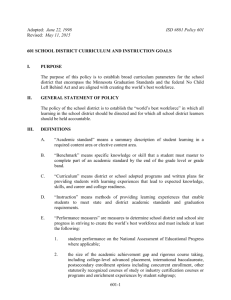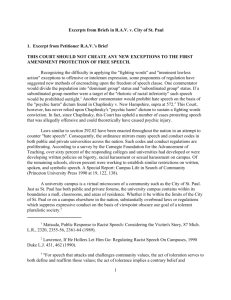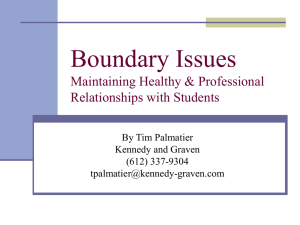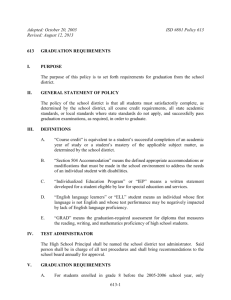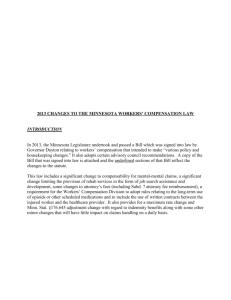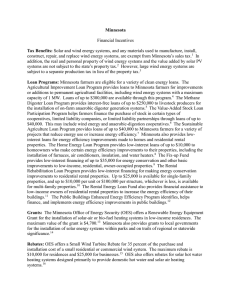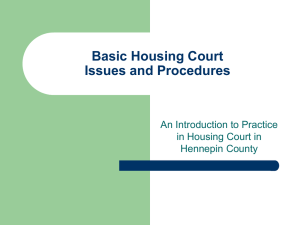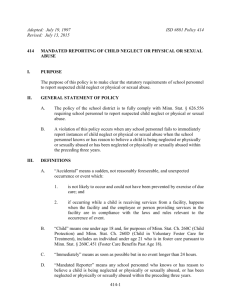Policy 616 School District System Accountability
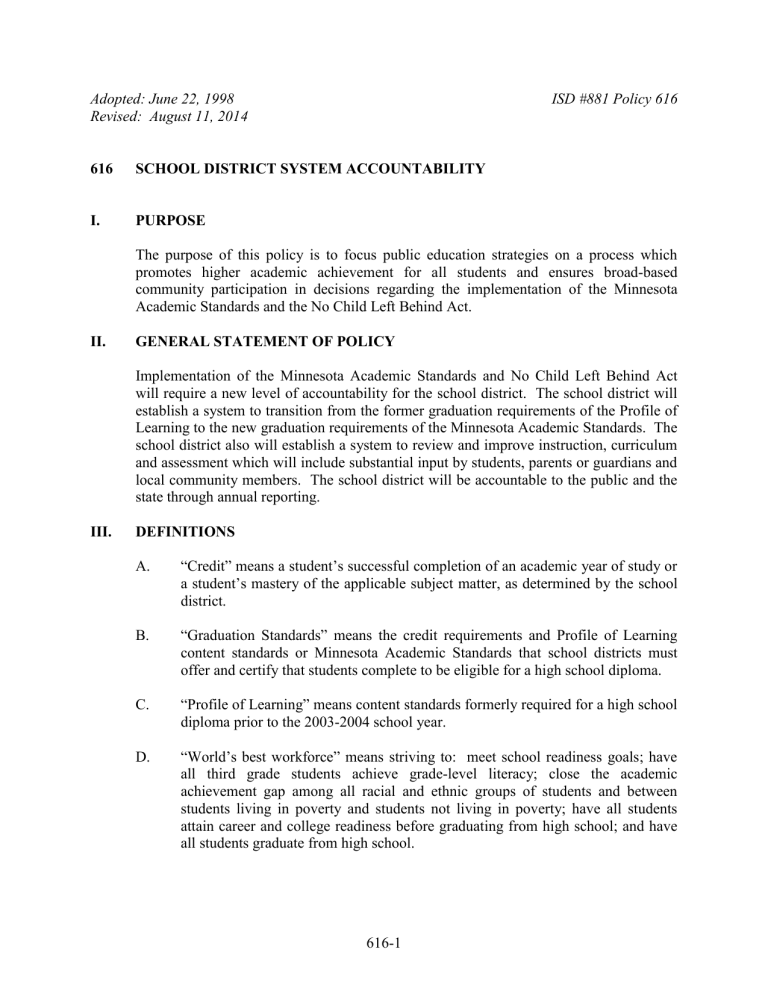
I.
Adopted: June 22, 1998
Revised: August 11, 2014
616 SCHOOL DISTRICT SYSTEM ACCOUNTABILITY
PURPOSE
ISD #881 Policy 616
The purpose of this policy is to focus public education strategies on a process which promotes higher academic achievement for all students and ensures broad-based community participation in decisions regarding the implementation of the Minnesota
Academic Standards and the No Child Left Behind Act.
II. GENERAL STATEMENT OF POLICY
Implementation of the Minnesota Academic Standards and No Child Left Behind Act will require a new level of accountability for the school district. The school district will establish a system to transition from the former graduation requirements of the Profile of
Learning to the new graduation requirements of the Minnesota Academic Standards. The school district also will establish a system to review and improve instruction, curriculum and assessment which will include substantial input by students, parents or guardians and local community members. The school district will be accountable to the public and the state through annual reporting.
III. DEFINITIONS
A.
“Credit” means a student’s successful completion of an academic year of study or a student’s mastery of the applicable subject matter, as determined by the school district.
B.
“Graduation Standards” means the credit requirements and Profile of Learning content standards or Minnesota Academic Standards that school districts must offer and certify that students complete to be eligible for a high school diploma.
C.
“Profile of Learning” means content standards formerly required for a high school diploma prior to the 2003-2004 school year.
D.
“World’s best workforce” means striving to: meet school readiness goals; have all third grade students achieve grade-level literacy; close the academic achievement gap among all racial and ethnic groups of students and between students living in poverty and students not living in poverty; have all students attain career and college readiness before graduating from high school; and have all students graduate from high school.
616-1
IV. ESTABLISHMENT OF GOALS; IMPLEMENTATION; EVALUATION AND
REPORTING
A. School District Goals
1. The school board has established school district-wide goals which provide broad direction for the school district. Incorporated in these goals are the graduation and education standards contained in the Minnesota Academic
Standards and the No Child Left Behind Act. The broad goals shall be reviewed annually and approved by the school board. The school board shall adopt annual goals based on the recommendations of the District
Leadership Team (DLT).
2. The improvement goals should address recommendations identified through the advisory committee process. The school district’s goal setting process will include consideration of individual site goals. School district goals may be developed through an education effectiveness program, an evaluation of student progress committee, or through some other locally determined process.
B. System for Reviewing All Instruction and Curriculum. Incorporated in the process will be analysis of the school district’s progress toward implementation of the Minnesota Academic Standards. Instruction and curriculum shall be reviewed and evaluated by taking into account strategies and best practices, student outcomes, principal evaluations under Minn. Stat. § 123B.147, Subd. 3, and teacher evaluations under Minn. Stat. § 122A.40, Subd. 8, or 122A.41, Subd. 5.
C. Implementation of Graduation Requirements
1. The school board shall appoint a Graduation Standards Implementation
Committee which shall advise the school board on implementation of the state and local graduation requirements, including K-12 curriculum, assessment, student learning opportunities, and other related issues.
Recommendations of this committee shall be published annually to the community. The school board shall receive public input and comment and shall adopt or update these policies at least annually. The Graduation
Standards Implementation Committee will be comprised of the District
Leadership Team.
2. The school board shall annually review and determine if student achievement levels at each school site meet federal expectations. If the school board determines that student achievement levels at a school site do not meet federal expectations and the site has not made adequate yearly progress for two consecutive school years, the District Leadership Team shall work with the school site to adopt a plan to raise student achievement levels to meet federal expectations. The District Leadership Team may seek assistance from the Commissioner of the Minnesota Department of
Education (MDE) (the Commissioner) in developing a plan which must
616-2
3. include parental involvement components.
The educational assessment system component utilized by the school board to measure individual students’ educational progress must be based, to the extent annual tests are administered, on indicators of achievement growth that show an individual student’s prior achievement. Indicators of achievement and prior achievement must be based on highly reliable statewide or districtwide assessments. The school board will utilize models developed by the Commissioner for measuring individual student progress. The school board must coordinate with the Department of
Education in evaluating school sites and continuous improvement plans, consistent with best practices.
D. Advisory Committee for Comprehensive Continuous Improvement of Student
Achievement
1. By September 15th of each year, the DLT will meet to advise and assist the school district in the implementation of the school district system accountability and comprehensive continuous improvement process.
2. The DLT, working in cooperation with other committees of the school district [such as the Technology, Building Leadership Teams, Grade
Level, etc.,] will provide active community participation in: a. Reviewing the school district instructional and curriculum plan, with emphasis on implementing the Minnesota Graduation
Standards;
3. b. c.
Identifying annual instruction and curriculum improvement goals for recommendation to the school board;
Making recommendations regarding the evaluation process that will be used to measure school district progress toward its goals; d.
The advisory committee shall meet the following criteria: a. The DLT shall ensure active community participation in all planning for instruction and curriculum affecting Graduation
Standards. b.
Advising the school board about development of the annual budget. c.
The DLT shall make recommendations to the school board on school district-wide standards, assessments and program evaluation.
Building teams may be established as subcommittees to develop
616-3
4.
5. d. and implement an education effectiveness plan and to carry out methods to improve instruction, curriculum, and assessments as well as methods to use technology in meeting the school district improvement plan.
A local plan to evaluate student progress, using a local process, shall be used for developing a plan for assessment of student progress toward the Graduation Standards, as well as program evaluation data for use by the advisory committee in the instruction and curriculum review process. This plan shall annually be approved by the school board.
The DLT shall, when possible, be comprised of community representatives and shall reflect the diversity of the community. Included in its membership should be: a. Teachers from each building b. c. d. e. f.
Support Staff Representative
School Board Member
Elementary and High School Principals
Parent Representatives
Superintendent g. School District Test Administrator (if different from above)
The DLT shall meet the following timeline each year:
August: Organizational meeting of the committee to review the authorizing legislation and the roles and responsibilities of the committee as determined by the school board.
September: Become familiar with the instruction and curriculum of the cycle content area.
October: Review evaluation results and prepare recommendations.
October: Present recommendations to the school board for its input and approval.
E. Evaluation of Student Progress Committee. A committee of professional staff shall develop a plan for assessment of student progress toward the Graduation
Standards, as well as program evaluation data for use by the advisory committee in the instruction and curriculum review process. This plan shall annually be
616-4
approved by the school board.
F. Educational Planning and Assessment System The school district may elect to participate in the Educational Planning and Assessment System (EPAS) program offered by ACT, Inc., to provide a longitudinal, systematic approach to student educational and career planning, assessment, instructional support, and evaluation.
G. Reporting. Consistent with Minn. Stat. § 120B.36, Subd. 1, the school board shall publish a report in the local newspaper with the largest circulation in the district, by mail, or by electronic means such as on the school district website. The school board shall hold an annual public meeting to review and revise, where appropriate, student achievement goals, local assessment outcomes, plans, strategies, and practices for improving curriculum and instruction, and to review school district success in realizing the previously adopted student achievement goals and related benchmarks and the improvement plans leading to the world’s best workforce. The school board must transmit an electronic summary of its report to the Commissioner in the form and manner the Commissioner determines. The school district shall periodically survey affected constituencies about their connection to and level of satisfaction with school. The school district shall include the results of this evaluation in its summary report to the
Commissioner.
Legal References:
Minn. Stat. § 120B.02 (Educational Expectations for Minnesota’s
Students)
Minn. Stat. § 120B.018 (Definitions)
Minn. Stat. § 120B.11 (School District Process)
Minn. Stat. § 120B.128 (Educational Planning and Assessment System
(EPAS) Program)
Minn. Stat. § 120B.35 (Student Achievement Levels)
Minn. Stat. § 120B.36 (School Accountability; Appeals Process)
Minn. Stat. § 122A.40, Subd. 8 (Employment; Contracts; Termination)
Minn. Stat. § 122A.41, Subd. 5 (Teacher Tenure Act; Cities of the First
Class; Definitions)
Minn. Stat. § 123B.04 (Site Decision Making Agreement)
Minn. Stat. § 123B.147, Subd. 3 (Principals)
Minn. Rules Parts 3501.0640-3501.0655 (Academic Standards for
Language Arts)
Minn. Rules Parts 3501.0700-3501.0745 (Academic Standards for
Mathematics)
Minn. Rules Parts 3501.0800-3501.0815 (Academic Standards for the
Arts)
Minn. Rules Parts 3501.0900-3501.0955 (Academic Standards in Science)
Minn. Rules Parts 3501.1300-3501.1345 (Academic Standards for Social
Studies)
20 U.S.C. § 6301, et seq.
(No Child Left Behind Act)
616-5
Cross References: ISD #881 Policy 104 (School District Mission Statement)
ISD #881 Policy 601 (School District Curriculum and Instruction Goals)
ISD #881 Policy 613 (Graduation Requirements)
ISD #881 Policy 614 (School District Testing Plan and Procedure)
ISD #881 Policy 615 (Testing, Accommodations, Modifications, and
Exemptions for IEPs, Section 504 Plans, and LEP Students)
ISD #881 Policy 617 (School District Ensurance of Preparatory and High
School Standards)
ISD #881 Policy 618 (Assessment of Student Achievement)
ISD #881 Policy 619 (Staff Development for Standards)
ISD #881 Policy 620 (Credit for Learning)
616-6
